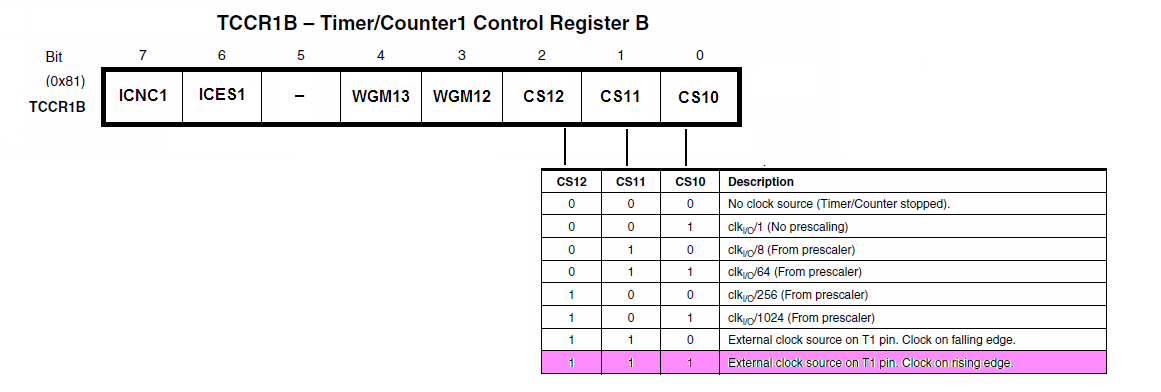AVR Example T1 counter: Rozdiel medzi revíziami
Zo stránky SensorWiki
Bez shrnutí editace |
Bez shrnutí editace |
||
| (Jedna medziľahlá úprava od rovnakého používateľa nie je zobrazená.) | |||
| Riadok 5: | Riadok 5: | ||
iny terminal aby sa to pekne vypisovalo: | iny terminal aby sa to pekne vypisovalo: | ||
<source lang="c"> | |||
<tabs> | |||
<tab name="Arduino"><source lang="c"> | |||
#define SWITCH 5 // select the pin for Switch | #define SWITCH 5 // select the pin for Switch | ||
| Riadok 30: | Riadok 32: | ||
} | } | ||
</source> | </source></tab> | ||
</tabs> | |||
| Riadok 39: | Riadok 42: | ||
[[Obrázok:AVR Timer TCNT1 Counter.png|center]] | [[Obrázok:AVR Timer TCNT1 Counter.png|center]] | ||
Nasledovny kus programu nastavi pocitadlo na 5 impulzov pred pretecenim (0xFFFF - 5) a | |||
potom sleduje v hlavnej slucke, kedy nastane pretecenie. Ako hodinky je pouzity externy | |||
signal na T1, cize tlacitko alebo 555. | |||
<source lang="C"> | |||
/* Example 9.2. Timer counter 1 in timer mode - pooled version */ | |||
#define SWITCH 5 // Arduino D5, ATmega328 PD.5 | |||
#define LED 13 // Arduino D13, ATmega328 PB.5 | |||
int ledState = LOW; // variable used to store the last LED status, to toggle the light | |||
void setup() // run once, when the sketch starts | |||
{ | |||
/* *********************** Init device ************************************ */ | |||
pinMode(SWITCH, INPUT); // this pin is an INPUT | |||
pinMode(LED, OUTPUT); | |||
Serial.begin(9600); | |||
Serial.println("Timer T1 test:"); | |||
TCCR1B = 0x07; // T1 clk = external clock source on pin T1, rising edge | |||
TCCR1A = 0x00; // T1 in timer mode | |||
TCNT1 = 0xFFFB; // initialize the counter (16-bit! Low+High bytes) | |||
TIFR1 = 0x01; // (1<<TOV1); if a 1 is written to a TOV1 bit | |||
// - the TOV1 bit will be cleared | |||
} | |||
/* *********************** Main Loop ************************************** */ | |||
void loop() // run over and over again | |||
{ | |||
if ( (TIFR1 & 0x01) == 0x01) // If the overflow flag is set | |||
{ | |||
ledState = !ledState; // toggle the status of the ledPin | |||
digitalWrite(LED, ledState); // update the LED pin itself | |||
TCNT1 = 0xFFFB; // Restart T1 - reload | |||
TIFR1 = 0x01; // Clear the overflow flag | |||
} | |||
else | |||
asm("nop"); // Do nothing | |||
Serial.print("Input D5 = "); | |||
Serial.print(digitalRead(SWITCH),BIN); | |||
Serial.print(" TCNT1 = "); | |||
Serial.print(TCNT1,DEC); | |||
Serial.print('\r'); // this will not work with embedded Serial Monitor, | |||
// but works fine with e.g. putty terminal | |||
} | |||
</source> | |||
Aktuálna revízia z 17:48, 21. február 2021
Tento program pouzije D5 (arduino) ako pocitadlo. Mozne pripojit tlacitko, alebo 555 a pocitat pocet impulzov.
Vstavany terminal Arduina nema formatovanie, takze treba pouzit iny terminal aby sa to pekne vypisovalo:
#define SWITCH 5 // select the pin for Switch
void setup()
{
pinMode(SWITCH, INPUT); // this pin is an INPUT
TCNT1 = 0x00; // initialize (CLEAR)counter
TCCR1B = 0x07; // T1 clk = external clock source on pin T1, rising edge
Serial.begin(9600);
Serial.println("Button test:");
}
void loop() // endless loop
{
Serial.print("Input D5 = ");
Serial.print(digitalRead(SWITCH),BIN);
Serial.print(" TCNT1 = ");
Serial.print(TCNT1,DEC);
Serial.print('\r'); // this will not work with embedded Serial Monitor,
// but works fine with e.g. putty terminal
delay(250); // wait 1/4s for another measurement
}


Nasledovny kus programu nastavi pocitadlo na 5 impulzov pred pretecenim (0xFFFF - 5) a
potom sleduje v hlavnej slucke, kedy nastane pretecenie. Ako hodinky je pouzity externy
signal na T1, cize tlacitko alebo 555.
/* Example 9.2. Timer counter 1 in timer mode - pooled version */
#define SWITCH 5 // Arduino D5, ATmega328 PD.5
#define LED 13 // Arduino D13, ATmega328 PB.5
int ledState = LOW; // variable used to store the last LED status, to toggle the light
void setup() // run once, when the sketch starts
{
/* *********************** Init device ************************************ */
pinMode(SWITCH, INPUT); // this pin is an INPUT
pinMode(LED, OUTPUT);
Serial.begin(9600);
Serial.println("Timer T1 test:");
TCCR1B = 0x07; // T1 clk = external clock source on pin T1, rising edge
TCCR1A = 0x00; // T1 in timer mode
TCNT1 = 0xFFFB; // initialize the counter (16-bit! Low+High bytes)
TIFR1 = 0x01; // (1<<TOV1); if a 1 is written to a TOV1 bit
// - the TOV1 bit will be cleared
}
/* *********************** Main Loop ************************************** */
void loop() // run over and over again
{
if ( (TIFR1 & 0x01) == 0x01) // If the overflow flag is set
{
ledState = !ledState; // toggle the status of the ledPin
digitalWrite(LED, ledState); // update the LED pin itself
TCNT1 = 0xFFFB; // Restart T1 - reload
TIFR1 = 0x01; // Clear the overflow flag
}
else
asm("nop"); // Do nothing
Serial.print("Input D5 = ");
Serial.print(digitalRead(SWITCH),BIN);
Serial.print(" TCNT1 = ");
Serial.print(TCNT1,DEC);
Serial.print('\r'); // this will not work with embedded Serial Monitor,
// but works fine with e.g. putty terminal
}